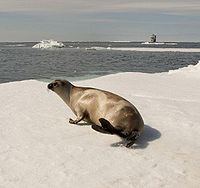Ribbon Seal
 From Conservapedia
From Conservapedia | Ribbon seal | |
|---|---|

| |
| Scientific classification | |
| Kingdom Information | |
| Kingdom | Animalia |
| Phylum Information | |
| Phylum | Chordata |
| Class Information | |
| Class | Mammalia |
| Order Information | |
| Order | Carnivora |
| Family Information | |
| Family | Phocidae |
| Genus Information | |
| Genus | Histriophoca |
| Species Information | |
| Species | H. fasciata |
| Population statistics | |
| Population | 300,000+ |
The ribbon seal (Histriophoca fasciata) is one of nine species of ice seals inhabiting the Arctic and is the only species in the genus Histriophoca. It's name is derived from the bold, ribbon-like pattern on its coat.
Contents
- 1 Description
- 2 Habitat and distribution
- 3 Threats
- 4 References
Description[edit]
Adult ribbon seals measure, on average, about 5 ft (1.5 m) long and weigh about 175 lbs (80 kg). Pups measure about 3 feet (1 m) at birth and weigh about 25 lbs (11 kg). Ribbon seals living in the southern part of the Okhotsk Sea tend to be bigger and heavier than those living elsewhere (Fedoseev 2002).
Ribbon seals consume about 20 lbs (9 kg) of food each day, mainly feeding on pelagic fish and invertebrates, such as shrimp, crabs, squid, octopus, cod, sculpin, pollack, and capelin. Juveniles feed mostly on krill and shrimp.
Pups are born with a wooly white lanugo coat, which they shed after the period of lactation, which lasts for 3–5 weeks. After one year, juveniles begin to develop a dark body and light bands encircling the neck, each front flipper, and hips. These light bands become brighter after another year. Males generally have darker bodies than females.
Ribbon seals alternate their foreflippers and swing their hindquarters to run across ice, rather than using the caterpillar-like movement typically used by most seals. Ribbon seals are also physiologically and anatomically adapted to make deeper dives (up to about 1950 ft (600 m)) and swim faster than other seals (Fedoseev 2002). They have an air sac that may function as a buoyancy device, for air storage during diving, or for "phonation" (Kelly 1988).
Ribbon seals become sexually mature after 3–5 years. Adult ribbon seals produce one offspring per year, and gestation lasts 11 months. They breed in May and give birth the following year between late March and April. Molting occurs annually between March and July; juveniles molt earlier and adults molt after giving birth. On average, ribbon seals live for about 20 years, but can reach up to about 30 years.
Habitat and distribution[edit]
Ribbon seals inhabit the North Pacific Ocean, specifically the Bering and Okhotsk Seas, and parts of the Arctic Ocean, including the Chukchi, eastern Siberian, and western Beaufort Seas. They are strongly associated with sea ice for mating, whelping pups and molting from mid-March through June. Most of the rest of the year is spent at sea; they are rarely seen on land. They seem to prefer moderately thick, stable, new, clean, white ice floes with even surfaces. They also avoid areas of thick ice. When the ice recedes and the breeding and molting seasons come to an end, ribbon seals move northward until the ice gets too thick and then remain in the water for the rest of the year. Little is known about the distribution of ribbon seals while they are pelagic.
Threats[edit]
Ribbon seals have been hunted for generations and are still hunted today by Siberia and Alaska natives for subsistence, but the number of seals harvested has always been relatively small (less than 100 in Alaska).
In the early 1950s, the USSR began commercially harvesting ribbon seals in the Sea of Okhotsk; the fishery quickly intensified in the 1960s, with an average of about 13,000 to 20,000 seals harvested per year. Ribbon seals were also hunted in the Bering Sea beginning in 1961, with an annual harvest of nearly 10,000 individuals. As the ribbon seal population declined, annual harvest also fell, dropping to 3,500 in the Sea of Okhotsk and 3,000 in the Bering Sea in the 1980s (Popov, 1982). Harvest continued to fluctuate in relation to ribbon seals abundance and political and economic unrest. Although the Russian governmentquotas recently put in place would allow large annual harvests (18,000), the annual harvest remains relatively low today.
Other human impacts to ribbon seals include growing oil and gas development in the Okhotsk and Bering Seas, oil spills, and incidental take in commercial fisheries.
References[edit]
- Fedoseev, G. (2002). "Ribbon seal Histriophoca fasciata." Pp. 1027-1030 in W. F. Perrin, B. Wursig, and J. G. M. Thiewissen, eds. Encyclopedia of Marine Mammals. Academic Press.
- Kelly, B. P. 1988. "Ribbon seal". Pages 95–106 in J. W. Lentfer, editor. Selected Marine Mammals of Alaska : Species Accounts with Research and Management Recommendations. Marine Mammal Commission, Washington, D.C.
- Popov, L. A. 1982. "Status of the Main Ice-Living Seals Inhabiting Inland Waters and Coastal Marine Areas of the USSR". Pages 361-381 in Mammals in the Seas. Vol IV. "Small Cetaceans, Seals, Sirenians and Otters". FAO Fisheries Series.
| Copyright Details | |
|---|---|
| License: | Some of this work is in the Public Domain in the United States because it is a work of the United States Federal Government under the terms of Title 17, Chapter 1, Section 105 of the U.S. Code |
| Source: | File available from the United States Federal Government [1]. |
| |||||||||||
Categories: [Marine Mammals]
↧ Download as ZWI file | Last modified: 02/18/2023 03:34:12 | 13 views
☰ Source: https://www.conservapedia.com/Ribbon_seal | License: CC BY-SA 3.0
 ZWI signed:
ZWI signed: KSF
KSF